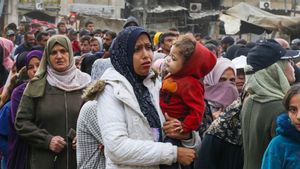JAKARTA - The government removed the death toll from the COVID-19 handling indicators. This decision is questionable because it smells of manipulation. The government is also considered blind to see death as a number. There's no plausible reason. This decision was careless and could harm many people.
Monday, August 9, Coordinating Minister for Maritime Affairs and Investment (Menko Marves) Luhut Binsar Pandjaitan announced the extension of the Implementation of Restrictions on Community Activities (PPKM) until August 16. The announcement was made by Luhut via the Presidential Secretariat's YouTube channel.
In addition to announcing the PPKM extension period, Luhut also stated that the government would remove the death toll from the COVID-19 handling indicators. The reason, said Luhut, was due to problems in data input caused by the accumulation of death cases in the previous few weeks.
"We carried out this evaluation by removing the mortality indicator in the assessment because we found that there was input data which was an accumulation of mortality rates over the past few weeks, causing distortions in the assessment," said Luhut, quoted by VOI, Tuesday, August 10.
The reason doesn't make sense. Griffith University epidemiologist Dicky Budiman said the data problem is an old one. The government does not seem concerned so far. In fact, until now Indonesia does not have factual data. In addition, the data collection also does not meet the population scale and the escalation of the pandemic.
"Because, for example, talking about daily case numbers, it's a lot of confusion. From the point of view that the test can't be real-time, it's still there. The test wasn't that day, but how many days later," said Dicky to VOI.
Logically, when there is a problem with data collection, it should be corrected, not eliminated. Dicky explained that the death rate is a mandatory indicator. Eliminating it would have very serious repercussions. Treatment strategies may deteriorate. The impact is disastrous for society.
"The impact is very serious, yes, it means we will be blind to the situation. The mortality indicator is a mandatory indicator. So the pandemic indicator has an early and late indicator. The initial indicator is daily cases, TPR (test positivity rate). If the final indicator is other than house occupancy sick, ICU, it's death," said Dicky.
Death is not just a number
What the government is actually doing shows a shallow way of thinking. It is very clear how the government only sees deaths as numbers. This way of thinking is not only insensitive but dangerous.
Dicky Budiman explained how one death is very important to be interpreted. In the dynamic situation of dealing with a pandemic, one death can mean a lot.
At its simplest, data on a person's death needs to be explored to be used as a basis for determining strategies to prevent other deaths. So what strategy to expect without mortality data?
"Obviously this disappearance is not only about the undetected death rate but also shows that when we strategize we don't have strong data," said Dicky.
"We can see why he died. Oh, it was found late. Why is it late? It turns out that he didn't get a quick test. Why did death also happen to those who had been fully vaccinated. Now, these are important data for strategy improvement."
"In developed countries, even one death becomes a case for learning. Why did this death occur. Now, we lose information that should be extracted as a strategy improvement. This of course affects the quality of handling the pandemic. The data is missing," Dicky completed his explanation.
Danger of manipulationIf it's not superficial thinking, then the government's reason for removing the death toll as an indicator of handling the pandemic could be even more dangerous: manipulation. The government is considered to have deliberately eliminated the death toll to give the impression that the pandemic is being handled properly.
We can see the indications. The elimination of the death rate from the COVID-19 handling indicator immediately had an impact on 26 districts/cities, whose PPKM levels dropped from level 4 to level 3.
"This shows a significant improvement in conditions on the ground," said Luhut explaining the latest pandemic situation.

This manipulation attempt is dangerous. According to Dicky, eliminating the death toll from the indicator will only give a good impression that the pandemic is being handled. The facts on the ground are not necessarily so.
"This is dangerous because when the indicator used for easing is not the TPR (test positivity rate) but eliminating deaths, it's dangerous because we don't look at it comprehensively. The navigation is not complete."
Eliminating the indicator of death can also be seen as an attempt to erase the sins of the government. In addition to indicating the severity, the death toll can also be used to measure the response of government authorities to the pandemic situation.
"Why is it important to look back on mortality data. That one death clearly indicates a failure in upstream interventions. This failure causes delays. Delays are detected, referred and treated," said Dicky.
"For example, in the last ten days before the end of the PPKM yesterday, if we calculate that 21 days ago there were a lot of undetected cases, right. The potential could be one million. Those are symptomatic and asymptomatic."
"It is true that some will recover on their own, but there will be a transmission process that continues if it is not detected. Both will become a burden in turn on health facilities and increase the mortality rate in the community. upstream," Dicky.
*Read other information about COVID-19 or read other interesting articles from Diah Ayu Wardani, Wardhany Tsa Tsia, and Yudhistira Mahabharata.
Other BERNASThe English, Chinese, Japanese, Arabic, and French versions are automatically generated by the AI. So there may still be inaccuracies in translating, please always see Indonesian as our main language. (system supported by DigitalSiber.id)













